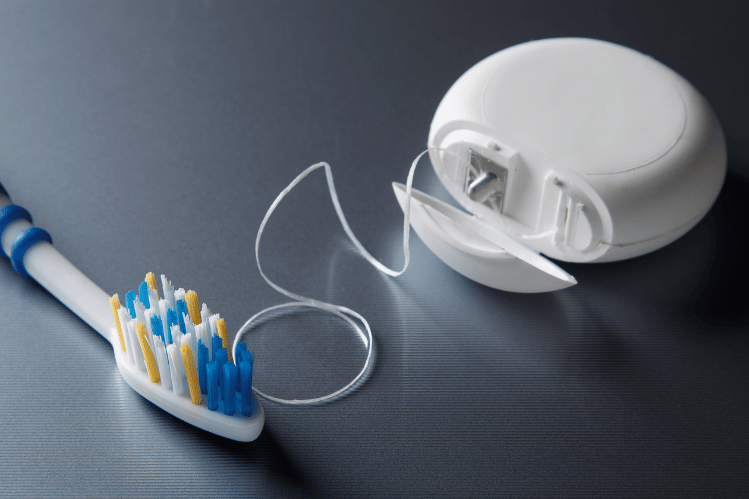
Table of Contents
-
What is Teeth Flossing
-
Types of Floss
-
Why Flossing is Essential
-
Steps for Flawless Flossing
-
Step 1: Choose Your Floss
-
Step 2: Use the Right Amount
-
Step 3: Hold the Floss Tightly
-
Step 4: Guide the Floss
-
Step 5: Form a C-shape
-
Step 6: Repeat the Process
-
Step 7: Rinse and Finish
-
How to Floss With Water Flosser
-
How to Floss With Braces
-
How to Floss With Clear Aligners
-
Tips For Smooth Flossing
-
Smilepath Australia — Your Ultimate Savior
-
Key Takeaways
-
FAQs
-
Related Blogs
Teeth flossing might seem like an extra step in your dental routine, but it is a game-changer for someone who is looking for ways to get a healthy, bright smile. The debris accumulated in the mouth contributes greatly to damage to oral health because the mouth has various corners for food to hide. Flossing comes to the rescue to avoid these threatening effects caused by food particles in the mouth.
In this blog, you will learn the art of flossing and its importance for your oral health.
What is Teeth Flossing
Flossing is vital for cleaning the oral cavity. It can involve using a fragile, soft thread or water to remove food particles, plaque, and bacteria from the gum line and teeth.
Flossing daily is essential for a healthier and cleaner mouth ensuring lifelong dental wellness.
Types of Floss
Several types of dental flossing are used according to your needs and preferences. The following bullet points explain different kinds of dental flossing techniques
1. Traditional Dental Floss

This is the most common type of dental flossing. It is further divided into two different forms
- Nylon Floss: it is made up of multiple strands. It can be waxed or unwaxed and is available in a variety of flavors. It's flexible but it may shred between tight teeth spaces.
- PTFE (Monofilament) floss: it's a single filament floss. It's smoother and durable and slides easily between teeth.
2. Floss Picks

These are small plastic tools. They include a short piece of floss stretched between two prongs. Floss picks are convenient and easy to use but they may not be effective at reaching deep parts of teeth.
3. Interdental Brushes

Interdental brushes are designed to clean the tight spaces between your teeth. They remove plaque and food debris accumulated between hard-to-reach areas and protect teeth from cavities and bacteria. They are especially useful for people with braces.
4. Super Floss

Super floss consists of 3 sections: a stiff end to thread, a spongy middle, and a regular floss to remove the plaque, they are ideal for people with braces or bridges.
5. Water Flossers

These are the devices that use a stream of water to remove debris and plaque from between the teeth and along a gum line. They are also called oral irrigators and dental water jets.
Why Flossing is Essential
It is never too late to make flossing a tooth-care habit. Here are some points to help you understand the importance of flossing:
To Remove Food Particles
Flossing is the most underrated yet effective weapon to remove food particles that are trapped between teeth. By regular flossing, you can ensure the removal of food particles that are accumulated. This will promote a clean oral environment and protect your oral health.
To Control Plaque Build-up
Plaque build-up between teeth increases the risk of tooth decay and cavities. Flossers reach and clean the areas that are out of reach for brushes. They remove the plaque before it hardens into tartar.
Improves Gum Health
Flossing reduces the risk of gum inflammation and gingivitis. It also prevents gums from bleeding and some serious gum diseases caused by cavities and bacteria.
Prevents Bad Breath
Regular brushing and flossing keep your breath fresh. They eliminate odor-causing bacteria which are formed due to food debris.
Steps for Flawless Flossing
Follow this step-by-step guide to floss your teeth correctly:
Step 1: Choose Your Floss
Pick the type of floss that aligns best with your needs.
Step 2: Use the Right Amount
Break off about 45cm of floss wrap most of it around the middle fingers of both hands and leave 1-2 inches of floss to work with.
Step 3: Hold the Floss Tightly
Hold the floss taut between your thumb and index fingers.
Step 4: Guide the Floss
Use index finger to guide floss up and down between contact of teeth, rubbing it against both sides of each tooth. Avoid gliding the floss into your gums to protect your gums from scratching and bleeding.
Step 5: Form a C-shape
When the floss gets to the gum line, curve it into a C shape around a tooth. This allows the floss to get into the area between the gum and the tooth.
Step 6: Repeat the Process
As you unwrap more floss, use a fresh section for each tooth. Repeat to clean every crevice and space.
Step 7: Rinse and Finish
To flush out any loosened debris from the mouth after flossing, rinse the mouth with water or mouthwash. Dispose of the used floss in such a manner that it can never be used again.
How to Floss With Water Flosser
Water flossers work a little differently from other flossing tools.
- Start by filling the water flosser’s reservoir with lukewarm water or mouthwash.
- Water flossers come with different tips. Select the right tip according to your needs.
- Adjust the water pressure. Start with lower water pressure if you are new to water flossing.
- Lean slightly over the sink to avoid water splashing. Place the tip in your mouth and close your lips slightly to prevent water from spraying out.
- Turn the device on and aim the tip at a 45-degree angle toward the gum line.
- Complete the process and spit out the remaining water.
How to Floss With Braces

If you have braces, flossing can be tricking and time-consuming, but it is as important with braces as it is without braces. Flossing with braces is similar to flossing with normal teeth with few exceptions.
- Stand in front of a mirror while flossing with braces to ensure floss is going where it is needed.
- Start by flossing between your teeth and braces wires.
- When working on your top teeth, try to make an upside-down U with the floss.
- Remove the floss gently and carefully unthread it from behind the wire to avoid dislodging a wire.
How to Floss With Clear Aligners
The procedure for flossing with clear aligners is similar to flossing with normal teeth. Clear aligners are specially made removable to allow you to maintain oral hygiene. You just have to simply remove your clear aligners if you want to brush or floss your teeth. Moreover, water flossers can also be used to clean your clear aligners. After flossing your teeth, floss your clear aligners also to ensure your teeth are well protected during teeth alignment procedure.
Tips For Smooth Flossing
Follow these basic tips to ensure proper and smooth flossing:
- Be sure to wash your hands before you reach for the floss.
- Be gentle while flossing to avoid any damage to the gums.
- If you are using a floss pick, angle it properly to reach the back teeth.
- Clean your floss every time after you are done flossing.
- Always floss before brushing your teeth to ensure thorough cleaning.
- Don’t forget your back teeth. Many people get confused about how to floss back teeth, but it's similar to flossing other teeth.
Smilepath Australia — Your Ultimate Savior
To start your oral health journey, choose Smilepath Australia Clear Aligners to treat your teeth misalignments. Getting straight teeth will make flossing a lot more easier and comfortable. However, Smilepath offers clear aligners that are highly adjustable and removable to make your flossing process seamless and convenient.
Key Takeaways
Flossing is a simple yet effective part of your oral hygiene. You just have to choose the type of floss according to your needs and make flossing a part of your routine to get a healthy mouth. Take out a significant part of your daily routine to pamper yourself and make flossing part of your self-care. It's preferable to floss at night to remove all the debris accumulated throughout the day. And if you are struggling with misaligned teeth, flossing can become difficult. Use Smilepath Clear Aligners to correct your misaligned teeth and get a healthy smile today!
FAQs
You should floss before you brush your teeth. Brushing your teeth after flossing will allow cleaning of any loose debris and dental plaque.
No, flossing doesn't create gaps between your teeth. Instead, it helps in revealing the natural space between your teeth by cleaning debris.
Flossing helps remove bad breath because it cleans odor-causing bacteria that are formed due to food accumulation.
Related Blogs
Citations:
Higuera, V. (2020a, January 8). What’s the best way to floss your teeth? Healthline. https://www.healthline.com/health/how-to-floss
Colgate. (n.d.-c). What is the right way to floss? Colgate. https://www.colgate.com/en-us/oral-health/brushing-and-flossing/flossing-how-to#
Web, M. (2023, October 16). The crucial role of flossing in clear aligners treatment. AlignerCo. https://alignerco.com/blogs/blog/the-crucial-role-of-flossing-in-clear-aligners-treatment?srsltid=AfmBOoo5vQQqUZs4GpTFtZ-Js_lK5OWg3VpW5AXVTKeEqxrl9v15IY2e
Flossing. (n.d.). MouthHealthy - Oral Health Information From the ADA. https://www.mouthhealthy.org/all-topics-a-z/flossing#:~:text=Hold%20the%20floss%20tightly%20against,very%20back%20of%20your%20mouth.
Higuera, V. (2020b, January 8). What’s the best way to floss your teeth? Healthline. https://www.healthline.com/health/how-to-floss#when-to-floss








 Australia
Australia New Zealand
New Zealand Malaysia
Malaysia English
English Portuguese
Portuguese English
English English
English English
English English
English English
English Canada
Canada